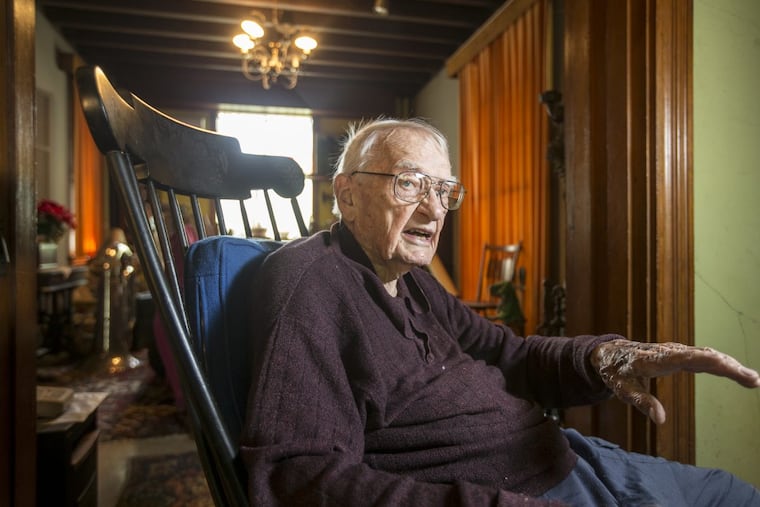Camden-born illustrator, turning 100, left his mark on Nazi trials | Stu Bykofsky
Joe Krush turns 100 on Friday and a party is being thrown by adult students in the painting and drawing class he's been teaching for 19 years at Radnor's Main Line School Night. But his birthday is not the most interesting thing about him.

"I'm a nobody."
That's what Joe Krush said when I said I wanted to tell his story: "I'm a nobody."
That's not true for most of the Greatest Generation and certainly not for Krush, whose skills as an illustrator took him to both the birth of the United Nations in San Francisco and the 1945-46 Nuremberg trials of the Nazi war machine.
Krush, a Camden native, and Beth, his wife of 67 years, who died in 2009, were prominent illustrators. Beth might have been best known for Jack and Jill magazine illustrations, while Joe ran the gamut from advertising to magazines to album covers for RCA Victor and other labels. Their son, Jay, teaches music at Temple University.
Krush turns 100 on Friday and a party is being thrown by adult students in the painting and drawing class he's been teaching for 19 years at Radnor's Main Line School Night. But his birthday is not the most interesting thing about him. Those who don't know his story can view a 50-minute documentary on YouTube called Joe Krush: An Illustrated Life.
The modest illustrator served in the Office of Strategic Services, the forerunner of the CIA.
After Pearl Harbor was attacked, Krush took his portfolio and tried to enlist in the Navy. During the war, anyone with unique talent was harnessed in the war effort. The Navy passed and suggested he call the Army.
"I enlisted in the Army by telephone," he says with a laugh, and was assigned to the 603rd Camouflage Engineers, Krush tells me as we sit in the cluttered living room of a rambling old house on a hill in Wayne that he renovated himself. ("I come from a long line of Polish woodworkers," he says.)
He later attended Officer Candidate School, which turned him into a second lieutenant.
After 15 months of teaching camouflage, Krush was invited to hook up with the new OSS, which needed his artistic skills. "I don't consider myself an artist," Krush tells me. "I'm an illustrator. Most artists, if they're painting something and you don't understand it," that's your problem. "If I illustrate something and you don't understand it, I failed."
He joined the OSS Presentation Group, which specialized in stagecraft. The Army transferred him to San Francisco — this was before the end of the war — and "suddenly I found myself working on something called U.N." The Presentation Group designed the whole signing ceremony — everything from selecting the furniture to the typography for the U.N. charter. The world's powers were gathering, and Krush was in the middle of it, and "I was a nobody," he says.
Krush's boss, Donal McLaughlin, got credit for the seal of the fledgling organization, but Krush and others participated in its design. The charter was signed June 26, 1945, in San Francisco, at the conclusion of the U.N. Conference on International Organization, and took effect Oct. 24, 1945.
Even before the U.N. met, "they told us to go to Nuremberg to facilitate the physical running of the [war crimes] trials," Krush recalls.
The Presentation Group created the courtroom, because no existing courtroom was large enough. Newsreels show the courtroom to be perfect, almost like a movie set. It kind of was: The Presentation Group "had stage designers from New York, they had Hollywood writers," architects and artists and furniture builders, Krush says.
His job was to prepare artwork for the trial — signage, passes, identification papers. "There was no Xerox," he says. "We had to do everything by hand."
He selected yellow and black as the colors for the temporary pass to the trials because "they were the colors the Jews had to wear under the Nazis," says Krush, a Catholic.
"Yes, I did do it," he says with a look of satisfaction.
He observed the trial from a window above the courtroom. He was disgusted by the Nazis, but thought "they looked like businessmen," elements of what the German-born writer Hannah Arendt later termed the "banality of evil."
When the war ended, Krush returned to his wife and his career. "I had a golden guardian angel," says Krush, when asked about his life and longevity.
You don't get a guardian angel if you are a nobody.